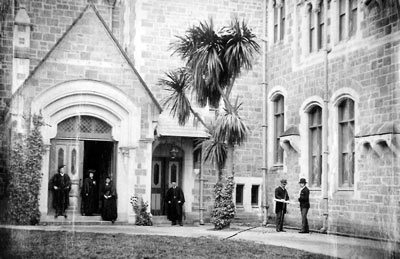Prior to the establishment of the Student Union and the common rooms system, some groups took rooms in town for private clubs to meet. O.T.J. Alpers remembered that “Life at the College meant much hard work and very little play for most of us; but on Saturday nights we relaxed – usually at the ‘Will o’ the Wisp’, an undergraduates club, where we drank small-beer and smoked meerschaum pipes.” The development of common rooms finally provided pleasant spaces for students to meet on campus. A men’s common room was constructed in 1888-1889 for £250. It was located at the eastern end of the south quad. The room might have provided space for study, but it certainly provided space for games. A student related that “In the Stud Room, we might smoke as we pleased, play cricket with the fire shovel for a bat and a two-penny bottle of ink to declare in a splash upon the wall that you were out, lose a few pence at poker or casino …and squabble over chess and draughts.”

Relaxation
In the first decade of Canterbury College students often found that the lack of buildings meant there were few opportunities for fellowship. According to Heinrich von Haast “We were [not] exposed to any temptation to linger at College once lectures were over. There was no library, no common room. The Dens, cold and cheerless, were the only places where students could foregather and the long rows of funeral black gowns, taps that dripped incessantly, and rafters that necessitated a more or less stooping position did not encourage loitering there.” Von Haast must have eventually found fellowship though, and was indeed instrumental in creating opportunities, as he is credited with penning the song ‘Long Live Canterbury College’ which was sung on Diploma Day in 1889.

Students in cap and gown outside the Great Hall, c.1890. Students were required to wear black academic gowns to lectures.

Students' Association advice for the new undergraduate.
Before a women’s room was provided, female students had met in a dusty room in the clock tower, which shook when the clock struck. Finally the women got their own common room in 1886, which was an old cottage in north-west corner of south quad. The appointments may not have been quite as good as in the men’s common room. A report in the College Review of June 1911 complains that the men’s common room not only got a billiard table and a piano, but also got a new coat of paint, while the women got nothing. They were still happy with their cottage. “In the end room, as our sitting room is sometimes designated, we possess no less than two bay windows, the one overlooking the lawn, and the other opposite the new chemistry establishment. We have a guardian angel in the shape of the stone creature who gazes in at our window from her lofty position above the entrance door of the chemistry laboratory.” The Angel would have been the College Coat of Arms.

An early design for a single storey Male Students Common Room. A two storey Common Room building, also known as the Lavatory Block, was completed in 1916, and later became the offices of Canta.
Thanks to the construction of the new Library, the women received an upgraded common room in 1917. The women’s committee noted that it was ‘new, clean and sometimes tidy’ with new chairs, lockers and even a piano. However they did not like the 51 steps up the stairs to reach the room, or the nearness of the lecture rooms, as the lecturers complained about noise levels in the common room. The women suggested that professors should understand, quipping that “He knows that talk a maiden must, for if she didn’t she would bust.” Common Rooms were divided into separate men’s and women’s domains until the Student Union building opened in 1929, where there were mixed spaces for socializing.